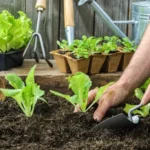Harvesting eggplants from your garden is always exciting, but knowing how to store them properly ensures you enjoy their fresh flavor longer. Eggplants are delicate and can spoil quickly if not handled right. With the right storage techniques, you can keep your harvest crisp and tasty for days or even weeks.
Whether you plan to use your eggplants soon or want to save them for later, understanding the best storage methods helps prevent waste and preserves their quality. From temperature tips to packaging ideas, you’ll learn how to extend the shelf life of your garden-fresh eggplants with ease.
Understanding Eggplant Storage Basics
To keep your garden eggplants fresh, understanding the basics of storage is essential. Proper handling and conditions preserve their texture and flavor.
Why Proper Storage Matters
Eggplants bruise easily, reducing their quality and shelf life. Storing them improperly causes moisture loss and accelerates spoilage. Maintaining freshness enhances taste and keeps nutrients intact until use.
Ideal Temperature and Humidity for Eggplants
Eggplants store best between 50°F and 54°F, cooler than room temperature but warmer than typical refrigerators. Humidity levels around 90-95% prevent drying and shriveling. Avoid temperatures below 50°F, which cause chilling injury and browning.
Preparing Eggplant for Storage
Proper preparation ensures your eggplant retains freshness and flavor longer. Follow careful harvesting, cleaning, and handling steps to maximize storage life.
Harvesting Tips for Longevity
Pick eggplants when their skin is glossy and firm without blemishes or soft spots. Harvest in the morning when temperatures are cooler to reduce field heat. Cut the stem with a sharp knife or clippers, leaving about one inch of the stem attached to avoid damage. Handle eggplants gently to prevent bruising, which accelerates spoilage. Avoid harvesting overly mature eggplants, as they tend to spoil faster and develop a bitter taste.
Cleaning and Handling Eggplants
Wipe eggplants with a damp cloth rather than washing them to prevent moisture absorption that can promote rot. Remove dirt carefully without rubbing the skin harshly. If you must rinse briefly, dry the eggplants thoroughly with a soft towel before storage. Avoid washing eggplants until right before use. Store eggplants away from ethylene-producing fruits like tomatoes or bananas to prevent premature ripening. Always place eggplants in a single layer or in well-ventilated containers to minimize pressure and bruising.
Storing Eggplant from the Garden
Storing eggplants properly keeps their texture and flavor intact for your meals. Use the right methods depending on how long you intend to keep the eggplants.
Short-Term Storage Methods
Store eggplants at 50°F to 54°F with 90-95% relative humidity to maintain freshness for up to 3 to 5 days. Place eggplants in a perforated plastic bag or wrap them loosely in a damp paper towel. Keep them in a single layer, avoiding stacking to prevent bruising. Store eggplants away from ethylene-producing fruits like tomatoes, bananas, or apples, since ethylene accelerates ripening and spoilage.
Long-Term Storage Techniques
Use freezing or pickling for eggplants you want to store longer than a week. To freeze, peel and cut eggplants into cubes or slices, blanch them in boiling water for 4 minutes, then cool in ice water. Drain completely and pack in airtight freezer bags. Frozen eggplants keep well for up to 12 months but may soften upon thawing, making them best for cooked dishes. For pickling, slice eggplants and immerse in a vinegar-based solution with spices. Store pickled eggplants in sterilized jars in the refrigerator or a cool, dark place for several months.
Avoiding Common Storage Mistakes
Avoid washing eggplants before storage since excess moisture speeds spoilage. Do not store eggplants below 50°F, as temperatures under this can cause chilling injury, leading to browning and decay. Refrain from placing eggplants in direct sunlight or warm environments, which encourage softening and shriveling. Finally, handle eggplants gently during harvesting and storage to minimize bruising, which shortens shelf life significantly.
Using Stored Eggplant
You can maximize the quality of your stored eggplant by recognizing spoilage signs and applying proper thawing and cooking methods. These steps ensure your eggplant remains flavorful and safe to consume.
Signs of Spoilage to Watch For
- Soft spots or mushy flesh indicating overripeness or rot
- Wrinkled or shriveled skin signaling moisture loss
- Discoloration, such as dark brown or black patches
- Mold growth appearing as white or green fuzzy spots
- Sour or off odors suggesting fermentation or decay
If you notice any of these signs, discard the eggplant to avoid foodborne illness.
Best Practices for Thawing and Cooking
- Thaw frozen eggplant in the refrigerator overnight to maintain texture
- Avoid thawing at room temperature, which promotes bacterial growth
- Use thawed eggplant promptly within 24 hours to preserve quality
- Roast, grill, or sauté thawed eggplant to bring out its flavors
- Incorporate thawed eggplant into stews, casseroles, or dips for best results
Proper thawing and cooking enhance the stored eggplant’s texture and taste, allowing you to enjoy your garden harvest fully.
Conclusion
Storing your garden-fresh eggplants properly ensures you enjoy their best flavor and texture. By controlling temperature and humidity and handling them gently, you can extend their freshness and reduce waste. Whether you’re storing them for a few days or preserving them long-term, following the right steps makes all the difference.
Pay attention to signs of spoilage and always store eggplants away from ethylene-producing fruits to keep them at peak quality. With these tips, you’ll get the most out of your harvest and enjoy delicious eggplants whenever you’re ready to cook.

Hi, I’m Md Rofiqul, a gardening enthusiast who loves spending time in the garden and backyard. I enjoy caring for plants, growing flowers and vegetables, and creating a green space that feels peaceful and refreshing. Gardening is more than just a hobby, it’s a passion that connects me to nature and brings joy to my daily life. Living with plants inspires me to embrace simplicity, patience, and sustainability while making every day more colorful and rewarding.

